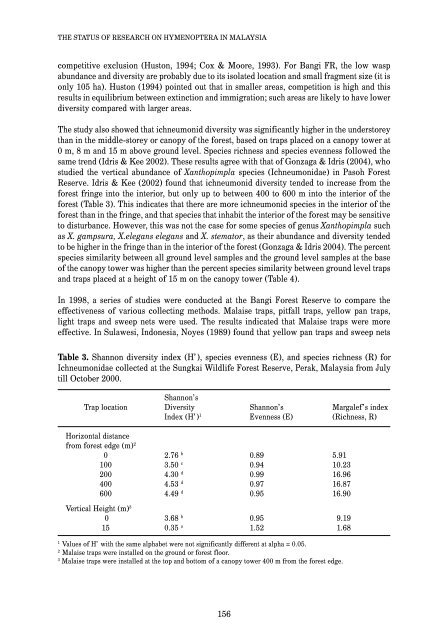o_19ko2dt161ng2j4e1tgnoqv1s45a.pdf
You also want an ePaper? Increase the reach of your titles
YUMPU automatically turns print PDFs into web optimized ePapers that Google loves.
THE STATUS OF RESEARCH ON HYMENOPTERA IN MALAYSIA<br />
competitive exclusion (Huston, 1994; Cox & Moore, 1993). For Bangi FR, the low wasp<br />
abundance and diversity are probably due to its isolated location and small fragment size (it is<br />
only 105 ha). Huston (1994) pointed out that in smaller areas, competition is high and this<br />
results in equilibrium between extinction and immigration; such areas are likely to have lower<br />
diversity compared with larger areas.<br />
The study also showed that ichneumonid diversity was significantly higher in the understorey<br />
than in the middle-storey or canopy of the forest, based on traps placed on a canopy tower at<br />
0 m, 8 m and 15 m above ground level. Species richness and species evenness followed the<br />
same trend (Idris & Kee 2002). These results agree with that of Gonzaga & Idris (2004), who<br />
studied the vertical abundance of Xanthopimpla species (Ichneumonidae) in Pasoh Forest<br />
Reserve. Idris & Kee (2002) found that ichneumonid diversity tended to increase from the<br />
forest fringe into the interior, but only up to between 400 to 600 m into the interior of the<br />
forest (Table 3). This indicates that there are more ichneumonid species in the interior of the<br />
forest than in the fringe, and that species that inhabit the interior of the forest may be sensitive<br />
to disturbance. However, this was not the case for some species of genus Xanthopimpla such<br />
as X. gampsura, X.elegans elegans and X. stemator, as their abundance and diversity tended<br />
to be higher in the fringe than in the interior of the forest (Gonzaga & Idris 2004). The percent<br />
species similarity between all ground level samples and the ground level samples at the base<br />
of the canopy tower was higher than the percent species similarity between ground level traps<br />
and traps placed at a height of 15 m on the canopy tower (Table 4).<br />
In 1998, a series of studies were conducted at the Bangi Forest Reserve to compare the<br />
effectiveness of various collecting methods. Malaise traps, pitfall traps, yellow pan traps,<br />
light traps and sweep nets were used. The results indicated that Malaise traps were more<br />
effective. In Sulawesi, Indonesia, Noyes (1989) found that yellow pan traps and sweep nets<br />
Table 3. Shannon diversity index (H’), species evenness (E), and species richness (R) for<br />
Ichneumonidae collected at the Sungkai Wildlife Forest Reserve, Perak, Malaysia from July<br />
till October 2000.<br />
Shannon’s<br />
Trap location Diversity Shannon’s Margalef’s index<br />
Index (H’) 1 Evenness (E) (Richness, R)<br />
Horizontal distance<br />
from forest edge (m) 2<br />
0 2.76 b 0.89 5.91<br />
100 3.50 c 0.94 10.23<br />
200 4.30 d 0.99 16.96<br />
400 4.53 d 0.97 16.87<br />
600 4.49 d 0.95 16.90<br />
Vertical Height (m) 3<br />
0 3.68 b 0.95 9.19<br />
15 0.35 a 1.52 1.68<br />
1<br />
Values of H’ with the same alphabet were not significantly different at alpha = 0.05.<br />
2<br />
Malaise traps were installed on the ground or forest floor.<br />
3<br />
Malaise traps were installed at the top and bottom of a canopy tower 400 m from the forest edge.<br />
156



